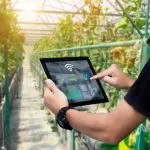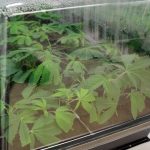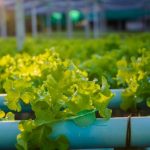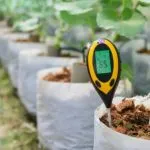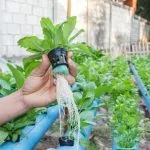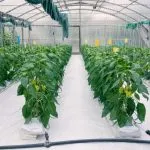Maintaining the ideal humidity levels in your grow tent is essential for the proper growth and development of your plants. This can be a challenge, especially if you are growing a tropical variety that requires higher humidity. If you find that the humidity levels in your grow tent are consistently too low, don’t worry – we’re here to show you how to raise humidity in a grow tent with a choice of several strategies.
One effective way to increase humidity is by adding more evaporated water to your grow tent. You can do this by placing wet sponges near any fans or air vents inside the tent. The heat and airflow will cause the water to evaporate over time, naturally boosting the humidity levels. Another simple method is placing a bucket or several small bowls of water in the tent. As the water evaporates, it raises the humidity level.
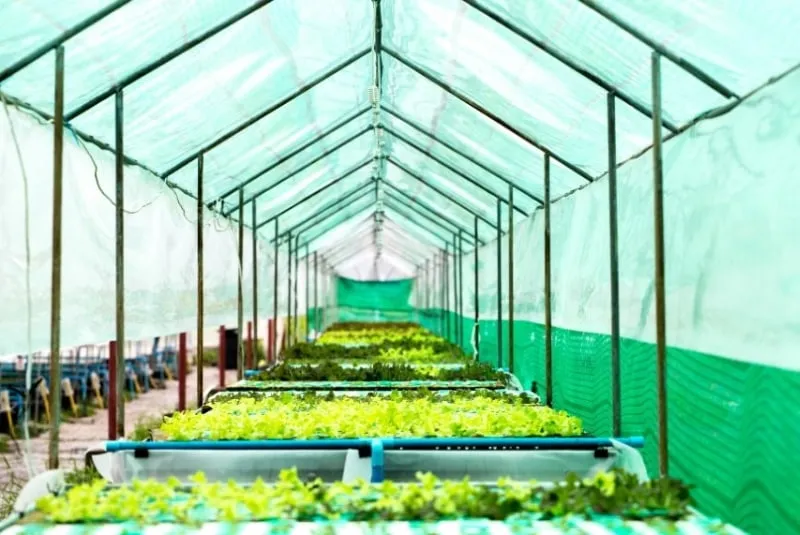
Apart from these two methods, there are various other ways to regulate humidity in your grow tent, such as using a humidifier, hanging wet towels, or adjusting the temperature surrounding the tent. Finding the right solution for your grow tent may take some trial and error, but with persistence, you’ll be able to create the perfect environment for your plants to thrive.
Understanding Humidity In Grow Tents
When you’re growing plants inside a grow tent, maintaining the proper humidity level is crucial for their health and productivity. Humidity refers to the amount of water vapor in the air, and in a grow tent, it’s important to maintain a balance that suits the plants you are cultivating.
There are two main types of humidity you should be aware of – relative humidity and specific humidity. Relative humidity refers to the ratio of the current water vapor in the air compared to the maximum amount it could hold at a given temperature. On the other hand, specific humidity refers to the actual amount of water vapor in the air, usually expressed as grams of water vapor per kilogram of air. Gain more insights about why hydroponics humidity matters.
Temperature plays a significant role in humidity management within your grow tent. As the temperature rises, the air can hold more water vapor, the specific humidity increases, and the relative humidity will decrease. Conversely, a drop in temperature results in increased relative humidity but a decrease in specific humidity, so it’s crucial to monitor air temperature and humidity in tandem.
To ensure your plants thrive, you need to control the humidity levels within your grow tent. There are several methods you can try, including:
- Placing a bowl of water in the tent to increase humidity through evaporation
- Hanging wet towels to add moisture to the air
- Using wet sponges and placing them near fans or air vents to raise humidity more quickly
- Investing in a humidifier designed for grow tents and fine-tuning its settings according to your plants’ needs
Make sure you regularly check the humidity levels inside your grow tent to keep your plants in optimal conditions. Remember to adjust the humidity according to the specific growth stage of your plants, as their requirements may vary.
Ways To Increase Humidity In Grow Tents
Using Humidifiers
Adding a grow tent humidifier to your setup is an effective way to increase humidity levels. Start by researching the tank capacity, run time, and coverage area of various humidifiers to find the best one for your plants. The requirements for these factors can vary depending on your grow tent size and your plants’ growing stage.
Where To Place Humidifier In Grow Tent
Once you have chosen the perfect humidifier for your grow tent, it’s important to place it in the correct spot. The optimal location for your humidifier is near the air intake of your grow tent. This helps to distribute humidified air evenly throughout the space and directly affects your plants.
How To Raise Humidity In Grow Tent Without Humidifier
If you don’t have access to a humidifier or want an inexpensive and easy way to raise humidity in a grow room, there are several alternatives:
Manipulating Ventilation And Air Flow
Adjust your tent’s ventilation system by closing some vents or reducing the fan speed. By doing so, you can retain more moisture in the air and raise the humidity level.
Applying Wet Towels And Sponges
Place wet towels or sponges near the fans or air vents inside your tent. The heat and airflow from the vents will cause water from the towels and sponges to evaporate, contributing to increased humidity.
Placing Water Bowls And Buckets
Another method is to place a bowl or bucket of water in your grow tent. The water will evaporate over time, slowly raising the humidity. To increase the rate of evaporation, try using a large, shallow container or placing multiple bowls around the tent.
Misting Plants Regularly
Use a spray bottle to mist your plants with water daily or as needed. Misting helps provide plants with direct moisture and can contribute to increased humidity in the grow tent. However, be cautious not to over-water your plants, as it may lead to mold or other issues.
Related: How does an aeroponic tower garden work? Find out now!
Monitoring And Controlling Grow Tent Environment
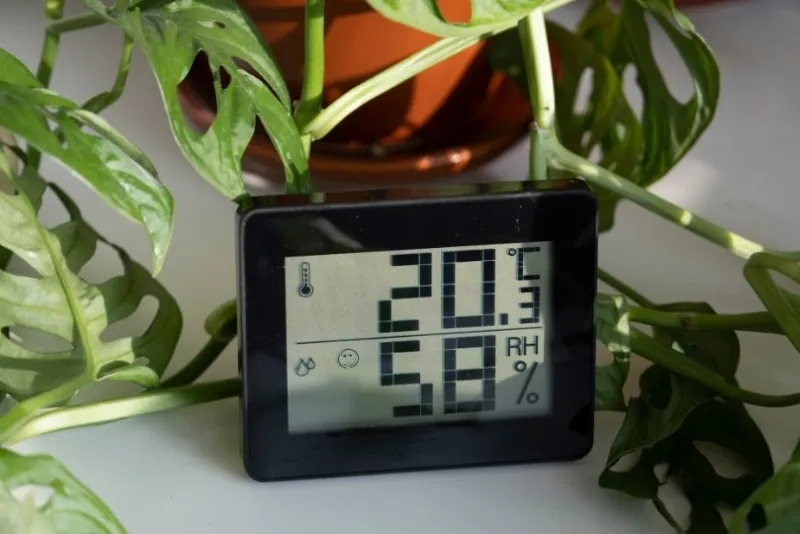
How and Where To Measure Humidity In Grow Room
To measure relative humidity in your grow room, use a digital hygrometer, which gives more accurate and clear readings. Place it in a central area of your grow tent, away from direct airflow, grow lights, and nearby walls, as these factors might affect the readings. Keep monitoring the humidity levels regularly to ensure a suitable environment for your plants.
Adjusting Grow Lights And Fan Speed
The intensity and positioning of your grow lights have a significant impact on temperature and humidity. Avoid placing them too close to your plants as this may cause overheating. You can adjust the height of your grow lights to maintain the ideal temperature and prevent excessive heat. Moreover, regulate the fan speed to balance the airflow inside your grow tent. Higher fan speed dissipates more moisture, while a slower speed retains it.
Here are a few tips for adjusting your grow lights and fan speed:
- Use a dimmable ballast for your grow lights to control the intensity.
- If you have LED grow lights, use adjustable spectrum models to manage the heat output.
- Adjust the height of your grow lights according to the growth stage of your plants.
- Experiment with different fan speeds for your ventilation fan to find the perfect balance.
Balancing Carbon Dioxide And Ventilation System
Proper ventilation is crucial for balancing humidity, temperature, and carbon dioxide levels in your grow tent. Implement a good ventilation system with an exhaust fan and, if needed, an air conditioner or dehumidifier. These devices can help maintain suitable environmental conditions for your plants. Remember, indoor growers should periodically introduce fresh air into the grow tent to replenish carbon dioxide levels.
When setting up the ventilation system:
- Use a fan controller to automatically speed up or slow down your ventilation fan in response to changes in temperature.
- Consider installing a carbon dioxide monitor to keep track of the levels within your grow tent. This is especially crucial for sealed grow rooms.
- Monitor your seedlings’ health and adjust your ventilation system accordingly.
With these measures in place, you can effectively monitor and control the environmental factors in your grow tent, providing your plants with the ideal conditions to thrive.
Managing Potential Risks And Issues
Avoiding Mold, Mildew, And Pests
To keep your grow tent humidity in check and avoid mold, mildew, and pests, ensure proper air circulation by using fans and vents. Regularly inspect your plants and remove any dead leaves or debris in the tent. Monitor the moisture level in the grow media only when necessary. By maintaining a clean environment and balanced humidity, you can prevent these issues from affecting your plants.
Preventing Nutrient Burn And Dehydration
High humidity can cause over-absorption of nutrients, leading to nutrient burn in your plants. To avoid this, monitor your plants’ foliage and look for any signs of discoloration or curling leaves. Adjust your nutrient solution if needed and maintain a consistent humidity level. On the other hand, low humidity can cause dehydration, especially in seedlings and young plants. Maintain a higher humidity level for these plants while keeping a close eye on their root development and overall health.
Optimizing Plant Growth And Yield
The ideal humidity level varies based on the stage of plant growth. For seedlings, aim for a humidity level between 65%-70%. As your plants transition to the vegetative stage, gradually decrease the humidity to around 50%. Mature plants prefer slightly lower humidity levels for optimal growth and yield. Keep in mind that succulents and some other plants may require different humidity ranges. Adjusting your grow tent’s humidity allows you to provide the best environment for the various growth stages, ultimately leading to higher yields and healthier plants.
Humidifier Not Raising Humidity In Grow Tent?
If you’re using a humidifier but still struggling to raise the humidity in your grow tent, consider implementing other methods such as adding a bowl of water, hanging wet towels, or placing soaked sponges near air vents. Also, check your grow tent for potential leaks or drafts, and ensure your humidifier is functioning correctly. Troubleshooting these issues will help you gain better control over your grow tent’s humidity, allowing your plants to thrive.

